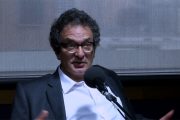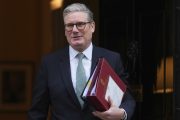
Margaret Thatcher, 87, who passed away on April 8 after suffering a stroke, was the longest-serving prime minister of Great Britain of the 20th century and the only woman to hold the post.
Margaret Hilda Roberts was the younger of the two daughters of Alfred and Beatrice Roberts. The family lived in a nondescript apartment above one of two grocery stores owned by Alfred. The business sense he derived from such a livelihood made him a conservative, and he shared that leaning with his daughters, especially with Margaret.
The future British leader studied chemistry at Oxford’s Somerville College where she became a leader of the university’s Conservative Association. Introduced to the value of political and economic freedom through the works of Friedrich von Hayek and Milton Friedman, she nevertheless began a career in the chemical industry and later obtained a law degree. Married to the well-to-do Denis Thatcher in 1951, she became the mother of twins, Mark and Carol, in 1953.
Soon seeking a political base, she won a seat in Parliament in 1959. From then on, she was given ever higher posts in the Conservative government and later, when the Conservatives lost power, she became the party’s leader in the field of education. In 1966, she was one of few members of parliament to support measures calling for decriminalizing male homosexuality and legalizing abortion. When the Conservatives again triumphed in 1970 and Edward Heath became prime minister, she served in his cabinet as secretary for education and science. In that post, she cut the budgets of the state education system, including a reduction in subsidies for a student milk program that earned her nationwide criticism. She later said that the milk issue taught her a valuable lesson: “I had incurred the maximum of political odium for the minimum of political benefit.” The lesson would guide much of her future decision-making.
In 1967, the U.S. Embassy in London selected her to take part in the U.S.-created Foreign Leader Program. This honor included a six-week visit to various U.S. cities, enabled her to meet with numerous American political figures, and helped her become familiar with American-based institutions such as the International Monetary Fund.
By 1975, Thatcher had risen to leadership of the Conservative Party. One year later, she pulled no punches in denouncing the ambitions of the leaders of the Soviet Union who she said were “bent on world dominance and they are rapidly acquiring the means to become the most powerful imperial nation the world has ever seen.” Her strident attack led a Soviet journalist to label her “the Iron Lady,” a sobriquet that stuck and even delighted her. She either didn’t know or refused to acknowledge that Western aid and trade to the Soviets, especially from the United States, was responsible for the Kremlin’s war-making buildup. It was during this period that she also took a stand against further British immersion into the European Union.
Four years later in 1979, the Conservatives won a fairly large majority in the House of Commons. As her party’s leader, she became the UK’s first female prime minister. Her rise to Britain’s topmost political post, which she held until 1990, overcame even her own frequently stated doubt that a female would ever occupy attain such a height.
At a time when government mismanagement and inflation had led to bankruptcy for 10,000 businesses, she set out to make government leaner and more efficient. Her oft-stated intention called for new policies that would “change Britain from a dependent to a self-reliant society, from a give-it-to-me to a do-it-yourself nation.” Her first target was the coal miners’ union, a battle most felt she could not win but one in which she eventually triumphed. She then won a reduction in payments to the European Union, forced the sell-off of numerous nationalized industries, initiated a mild form of privatization, cut subsidies to failing entities, and took the government out of much of the housing industry. She also refused to give in to the demands of the Irish Republican Army and even survived a 1984 assassination attempt that IRA leaders boasted was their work.
In 1982, her reputation as a world leader rose when she sent forces to defend the British-owned Falkland Islands from an invasion by troops from nearby Argentina, even rebuffing then-Secretary of State Alexander Haig’s plea that she avoid a military response. In less than two weeks, British forces had routed the Argentines although the cost included 255 British fatalities and 649 dead Argentinians. In a seeming reversal of her militarism, she protested when newly elected Ronald Reagan sent U.S. troops into the British territory of Grenada to oppose a suspected communist takeover. She would later submit to demands from Communist China to turn over the British possession of Hong Kong to Beijing’s control.
Thatcher inexplicably supported Cambodia’s murderous Khmer Rouge at the UN, gave permission for U.S. fighter planes based in England to attack Libya in 1986, and later pushed President George H.W. Bush to take action against Iraq after Saddam Hussein’s forces had marched into Kuwait.
Perhaps the U.K.’s first and only female prime minister is best remembered for friendships with two other national leaders: 1) her strong association with President Ronald Reagan, and 2) the dignity she supplied to Soviet leader Mikhail Gorbachev. Even though she once boasted that had she been Britain’s leader in the latter part of the 18th century, the United States would still be a British possession, the Thatcher-Reagan bond was unique as both leaders were being given undeserved adulation for adherence to hardline free market economic policies. Under Reagan, of course, the U.S. national indebtedness rose steadily despite media claims that government was being starved. In Britain, similar reporting greatly overstated the government’s somewhat meager contractions.
With Gorbachev, a surprising love fest developed — mostly through her actions. While Thatcher had previously denounced Soviet conduct and intentions, she welcomed the soon-to-be Soviet leader with almost girlish fascination. Even before Gorbachev assumed command in Moscow, she invited him to Britain in 1984 and gushed, “I like Mr. Gorbachev. We can do business together.” She thereby overlooked his lifetime of service in the murderous Soviet leadership, his steady rise to become its powerful leader through membership in the Politburo’s criminal clique, and his being tapped for leadership by KGB head Yuri Andropov. Gorbachev later presided over the highly questionable demise of communist control of Russia and has since become a crusader for questionable environmental claims and an array of attacks on national sovereignty. His Gorbachev Foundation keeps him in regal style and his Green Cross International, a leading sponsor of the subversive Earth Charter, works to steer mankind into a United Nations-led new world order. If the truth about Gorbachev’s entire career as a top functionary of the murderous Soviet system had been pointed to by Margaret Thatcher, and had she properly recoiled from it, she would have had little or nothing to do with Mikhail Gorbachev.
Current Prime Minister David Cameron somewhat grudgingly commented on Thatcher’s passing, “We can’t deny that Lady Thatcher divided opinion.” Many recall that her downfall at the end of her 11 years at Britain’s helm resulted from her attempt to impose a “community charge,” a tax on virtually every citizen. But even today, partisans who admired her consider her “the woman who saved Britain.” Opponents prefer to condemn her for a “cruel and nasty” attitude toward welfare recipients.
Without question, Margaret Thatcher helped her country, but only in a limited way. But also without question, she played the game of the international politician who never posed a threat to the new world order that she had to know was being built and should have been opposed.
Photo of Margaret Thatcher: AP Images



